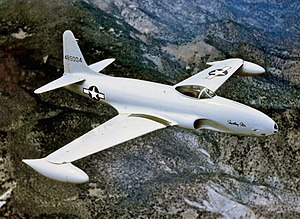| P-80 / F-80 Shooting Star | |
|---|---|
 P-80A with "tip tanks" | |
| General information | |
| Type | Jet fighter |
| National origin | United States |
| Manufacturer | Lockheed Corporation |
| Designer | |
| Primary users | United States Air Force |
| Number built | 1,715 |
| History | |
| Manufactured | 1945–1950 |
| Introduction date | 1945 |
| First flight | 8 January 1944 |
| Retired | 1959 (United States) 1974 (Chile) |
| Developed into | Lockheed T-33 Shooting Star Lockheed F-94 Starfire |
The Lockheed P-80 Shooting Star is the first jet fighter used operationally by the United States Army Air Forces (USAAF) during World War II.[1] Designed and built by Lockheed in 1943 and delivered just 143 days from the start of design, two pre-production models saw limited service in Italy just before the end of World War II. Designed with straight wings, the type saw extensive combat in Korea with the United States Air Force (USAF) as the F-80.
America's first successful turbojet-powered combat aircraft, it was soon outclassed with the appearance of the swept-wing transonic MiG-15 and was quickly replaced in the air superiority role by the transonic F-86 Sabre. The F-94 Starfire, an all-weather interceptor using the same airframe, also saw Korean War service. The closely related T-33 Shooting Star trainer remained in service with the U.S. Air Force and Navy well into the 1980s, with the last NT-33 variant not retired until April 1997.
- ^ Green and Swanborough 2001, p. 345.